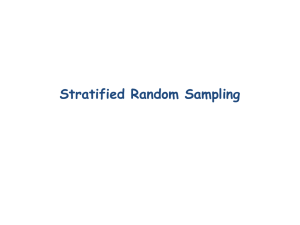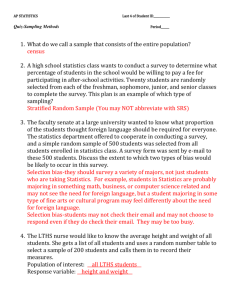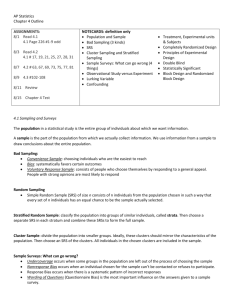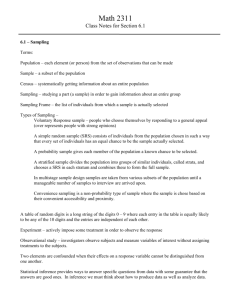Statistics Cheat Sheet
advertisement
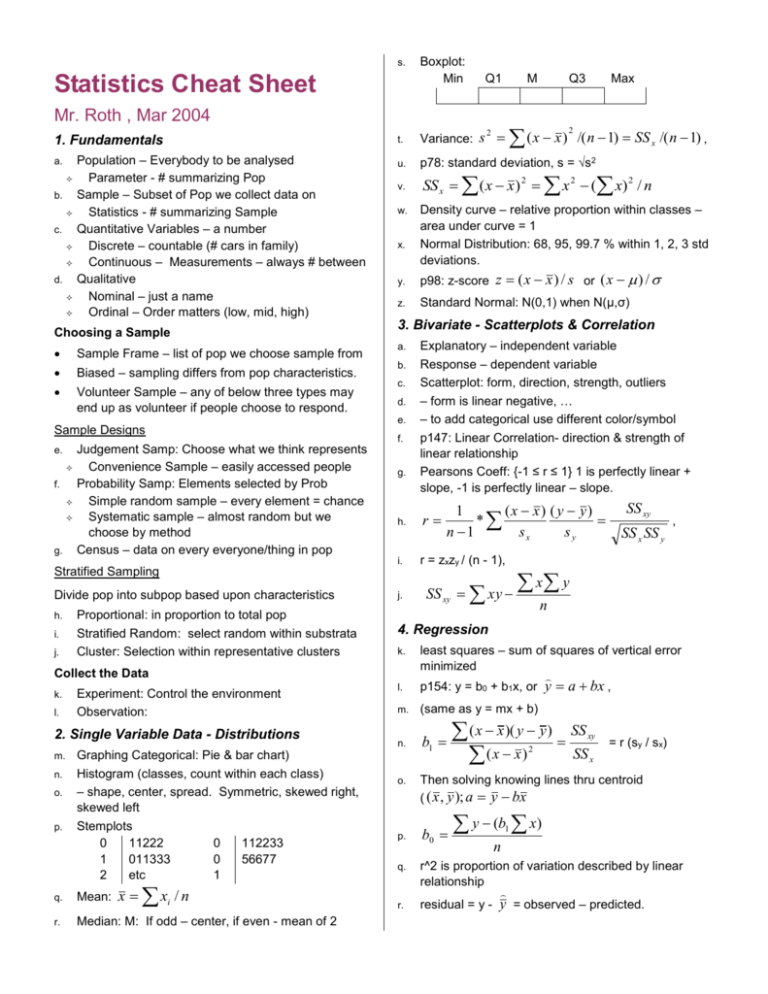
s.
Statistics Cheat Sheet
Boxplot:
Min
Q1
M
Mr. Roth , Mar 2004
1. Fundamentals
a.
b.
c.
d.
Population – Everybody to be analysed
Parameter - # summarizing Pop
Sample – Subset of Pop we collect data on
Statistics - # summarizing Sample
Quantitative Variables – a number
Discrete – countable (# cars in family)
Continuous – Measurements – always # between
Qualitative
Nominal – just a name
Ordinal – Order matters (low, mid, high)
Choosing a Sample
u.
p78: standard deviation, s = √s2
v.
SS x ( x x ) 2 x 2 ( x) 2 / n
w.
x.
Standard Normal: N(0,1) when N(μ,σ)
3. Bivariate - Scatterplots & Correlation
b.
Volunteer Sample – any of below three types may
end up as volunteer if people choose to respond.
g.
c.
d.
e.
f.
g.
h.
i.
Stratified Sampling
Divide pop into subpop based upon characteristics
h.
i.
j.
Proportional: in proportion to total pop
Stratified Random: select random within substrata
Cluster: Selection within representative clusters
j.
l.
Experiment: Control the environment
Observation:
2. Single Variable Data - Distributions
m.
n.
o.
p.
Graphing Categorical: Pie & bar chart)
Histogram (classes, count within each class)
– shape, center, spread. Symmetric, skewed right,
skewed left
Stemplots
0
11222
0
112233
1
011333
0
56677
2
etc
1
x xi / n
q.
Mean:
r.
Median: M: If odd – center, if even - mean of 2
Explanatory – independent variable
Response – dependent variable
Scatterplot: form, direction, strength, outliers
– form is linear negative, …
– to add categorical use different color/symbol
p147: Linear Correlation- direction & strength of
linear relationship
Pearsons Coeff: {-1 ≤ r ≤ 1} 1 is perfectly linear +
slope, -1 is perfectly linear – slope.
r
1
(x x) ( y y)
*
n 1
sx
sy
SS xy
,
SS x SS y
r = zxzy / (n - 1),
SS xy xy
x y
n
4. Regression
k.
Collect the Data
k.
Density curve – relative proportion within classes –
area under curve = 1
Normal Distribution: 68, 95, 99.7 % within 1, 2, 3 std
deviations.
z.
Biased – sampling differs from pop characteristics.
f.
/( n 1) SS x /( n 1) ,
p98: z-score z ( x x ) / s or ( x ) /
2
y.
a.
Judgement Samp: Choose what we think represents
Convenience Sample – easily accessed people
Probability Samp: Elements selected by Prob
Simple random sample – every element = chance
Systematic sample – almost random but we
choose by method
Census – data on every everyone/thing in pop
2
Variance: s
Sample Frame – list of pop we choose sample from
e.
(x x)
Max
t.
Sample Designs
Q3
least squares – sum of squares of vertical error
minimized
l.
p154: y = b0 + b1x, or y a bx ,
m.
(same as y = mx + b)
n.
b1
o.
p.
( x x )( y y ) SS
SS
(x x)
xy
2
= r (sy / sx)
x
Then solving knowing lines thru centroid
( ( x , y ); a y bx
b0
y (b x)
1
n
q.
r^2 is proportion of variation described by linear
relationship
r.
residual = y -
y = observed – predicted.
Statistics Cheat Sheet
s.
t.
u.
v.
Outliers: in y direction -> large residuals, in x
direction -> often influential to least squares line.
Extrapolation – predict beyond domain studied
Lurking variable
Association doesn't imply causation
5. Data – Sampling
a.
b.
c.
d.
e.
f.
g.
h.
i.
j.
k.
b.
c.
d.
e.
f.
g.
h.
i.
j.
k.
e.
f.
g.
h.
Population: entire group
Sample: part of population we examine
Observation: measures but does not influence
response
Experiment: treatments controlled & responses
observed
Confounded variables (explanatory or lurking) when
effects on response variable cannot be distinguished
Sampling types: Voluntary response – biased to
opinionated, Convenience – easiest
Bias: systematically favors outcomes
Simple Random Sample (SRS): every set of n
individuals has equal chance of being chosen
Probability sample: chosen by known probability
Stratified random: SRS within strata divisions
Response bias – lying/behavioral influence
6. Experiments
a.
d.
Subjects: individuals in experiment
Factors: explanatory variables in experiment
Treatment: combination of specific values for each
factor
Placebo: treatment to nullify confounding factors
Double-blind: treatments unknown to subjects &
individual investigators
Control Group: control effects of lurking variables
Completely Randomized design: subjects allocated
randomly among treatments
Randomized comparative experiments: similar
groups – nontreatment influences operate equally
Experimental design: control effects of lurking
variables, randomize assignments, use enough
subjects to reduce chance
Statistical signifi: observations rare by chance
Block design: randomization within a block of
individuals with similarity (men vs women)
i.
j.
k.
p. 197 Complementary Events P(A) + P( A ) = 1
m. p200: Mutually exclusive events: both can't happen
at the same time
n. p203. Addition Rule: P(A or B) = P(A) + P(B) – P(A
and B) [which = 0 if exclusive]
o. p207: Independent Events: Occurrence (or not) of A
does not impact P(B) & visa versa.
p. Conditional Probability: P(A|B) – Probability of A
given that B has occurred. P(B|A) – Probability of B
given that A has occurred.
q. Independent Events iff P(A|B) = P(A) and P(B|A) =
P(B)
r.
Special Multiplication. Rule: P(A and B) = P(A)*P(B)
s. General mult. Rule: P(A and B) = P(A)*P(B|A) =
P(B)*P(A|B)
t.
Odds / Permutations
u. Order important vs not (Prob of picking four
numbers)
v. Permutations: nPr, n!/(n – r)! , number of ways to
pick r item(s) from n items if order is important :
Note: with repetitions p alike and q alike = n!/p!q!.
w. Combinations: nCr, n!/((n – r)!r!) , number of ways
to pick r item(s) from n items if order is NOT
important
x. Replacement vs not (AAKKKQQJJJJ10) (a) Pick an
A, replace, then pick a K. (b) Pick a K, keep it, pick
another.
y. Fair odds - If odds are 1/1000 and 1000 payout. May
take 3000 plays to win, may win after 200.
l.
8. Probability Distribution
a.
7. Probability & odds
a.
b.
c.
2 definitions:
1) Experimental: Observed likelihood of a given
outcome within an experiment
2) Theoretical: Relative frequency/proportion of a
given event given all possible outcomes (Sample
Space)
533581123
-2-
Event: outcome of random phenomenon
n(S) – number of points in sample space
n(A) – number of points that belong to A
p 183: Empirical: P'(A) = n(A)/n = #observed/
#attempted.
p 185: Law of large numbers – Exp -> Theoret.
p. 194: Theoretical P(A) = n(A)/n(S) ,
favorable/possible
0 ≤ P(A) ≤ 1, ∑ (all outcomes) P(A) = 1
p. 189: S = Sample space, n(S) - # sample points.
Represented as listing {(, ), …}, tree diagram, or grid
b.
c.
d.
Refresh on Numb heads from tossing 3 coins. Do
grid {HHH,….TTT} then #Heads vs frequency
chart{(0,1), (1,3), (2,3), (4,1)} – Note Pascals triangle
Random variable – circle #Heads on graph above.
"Assumes unique numerical value for each outcome
in sample space of probability experiment".
Discrete – countable number
Continuous – Infinite possible values.
Printed 3/8/2016
Statistics Cheat Sheet
Probability Distribution: Add next to coins frequency
chart a P(x) with 1/8, 3/8, 3/8, 1/8 values
f.
Probability Function: Obey two properties of prob.
(0 ≤ P(A) ≤ 1, ∑ (all outcomes) P(A) = 1.
g. Parameter: Unknown # describing population
h. Statistic: # computed from sample data
Sample
Population
Mean
x
μ - mu
e.
Standard
deviation
i.
Base:
σ2
σ - sigma
s2
s
Variance
x x/n, s
2
(x x)
Me
an
Var
x xf / f
s2
(x x) f
( f 1)
Statistical Inference: methods for inferring data
about population from a sample
b.
If x is unbiased, use to estimate μ
c.
Confidence Interval: Estimate+/- error margin
Confidence Level C: probability interval captures
true parameter value in repeated samples
Given SRS of n & normal population, C confidence
d.
e.
f.
2
g.
Probability Distribution
h.
2 [( x ) 2 P( x)]
i.
j.
k.
Std
Dv
j.
s = √s2
Probability acting as an
2
l.
f / f . Lose the -1
9. Sampling Distribution
x
a.
By law of large #'s, as n -> population,
b.
Given x as mean of SRS of size n, from pop with μ
and σ. Mean of sampling distribution of x is μ and
standard deviation is
c.
/ n
d.
Significance level α : if α = .05, then happens no
more than 5% of time. "Results were significant (P <
.01 )"
Level α 2-sided test rejects Ho: μ = μo when uo falls
outside a level 1 – α confidence int.
Complicating factors: not complete SRS from
population, multistage & many factor designs,
outliers, non-normal distribution, σ unknown.
Under coverage and nonresponse often more
serious than the random sampling error accounted
for by confidence interval
Type I error: reject Ho when it's true – α gives
probability of this error
Type II error: accept Ho when Ha is true
Power is 1 – probability of Type II error
a.
Central Limit Theorem: Given SRS of b from a
population with μ and σ. When n is large, the
b.
10. Binomial Distribution
c.
Binomial Experiment. Emphasize Bi – two possible
outcomes (success,failure). n repeated identical
trials that have complementary P(success) +
P(failure) = 1. binomial is count of successful trials
where 0≤x≤n
p : probability of success of each observation
Binomial Coefficient: nCk = n!/(n – k)!k!
d.
Binomial Prob: P(x = k) =
e.
Binomal μ = np
f.
Binomal
b.
x
n.
o.
/ n)
Assess evidence supporting a claim about popu.
Idea – outcome that would rarely happen if claim
were true evidences claim is not true
Ho – Null hypothesis: test designed to assess
evidence against Ho. Usually statement of no effect
Ha – alternative hypothesis about population
parameter to null
Two sided: Ho: μ = 0, Ha: μ ≠ 0
P-value: probability, assuming Ho is true, that test
statistic would be as or more extreme (smaller Pvalue is > evidence against Ho)
z=
sample mean x is approx normal.
a.
Sample size for desired margin of error – set +/value above & solve for n.
m.
If individual observations have normal distribution
N(μ,σ) – then x of n has N(μ,
x z * / n
12. Tests of significance
[ xP( x)]
2
a.
interval for μ is:
(n 1)
Frequency Dist
11. Confidence Intervals
c.
d.
e.
/ n
n k
nk
p (1 p)
k
533581123
np(1 p)
-3-
Printed 3/8/2016


